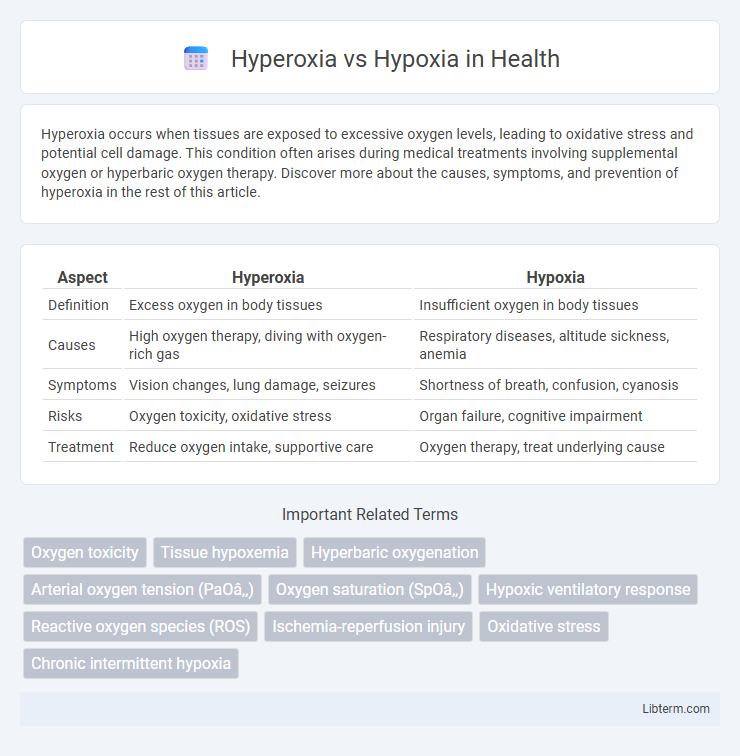Hyperoxia occurs when tissues are exposed to excessive oxygen levels, leading to oxidative stress and potential cell damage. This condition often arises during medical treatments involving supplemental oxygen or hyperbaric oxygen therapy. Discover more about the causes, symptoms, and prevention of hyperoxia in the rest of this article.
Table of Comparison
| Aspect | Hyperoxia | Hypoxia |
|---|---|---|
| Definition | Excess oxygen in body tissues | Insufficient oxygen in body tissues |
| Causes | High oxygen therapy, diving with oxygen-rich gas | Respiratory diseases, altitude sickness, anemia |
| Symptoms | Vision changes, lung damage, seizures | Shortness of breath, confusion, cyanosis |
| Risks | Oxygen toxicity, oxidative stress | Organ failure, cognitive impairment |
| Treatment | Reduce oxygen intake, supportive care | Oxygen therapy, treat underlying cause |
Introduction to Hyperoxia and Hypoxia
Hyperoxia refers to the condition where tissues are exposed to an excess supply of oxygen, often due to supplemental oxygen therapy or hyperbaric oxygen treatment. Hypoxia occurs when there is an insufficient oxygen supply to tissues, resulting from conditions like respiratory disorders, high altitude, or circulatory impairments. Both states affect cellular metabolism and can lead to oxidative stress or tissue damage depending on the severity and duration of oxygen imbalance.
Defining Hyperoxia: Causes and Effects
Hyperoxia occurs when tissues are exposed to an excess of oxygen, usually due to high supplemental oxygen levels or hyperbaric oxygen therapy. Causes include prolonged use of oxygen tanks, mechanical ventilation, or diving with high oxygen mixtures. Effects of hyperoxia involve oxidative stress leading to cellular damage, lung injury such as oxygen toxicity, and vasoconstriction that can impair organ function.
Understanding Hypoxia: Types and Triggers
Hypoxia occurs when tissues receive insufficient oxygen, categorized into hypoxic, anemic, circulatory, and histotoxic types based on underlying causes. Hypoxic hypoxia results from low arterial oxygen tension due to high altitude or respiratory diseases, while anemic hypoxia involves reduced oxygen-carrying capacity of blood, often from anemia or carbon monoxide poisoning. Circulatory hypoxia stems from inadequate blood flow, as seen in heart failure or shock, and histotoxic hypoxia arises when cells cannot utilize oxygen effectively, typically due to toxins like cyanide.
Cellular Responses to Oxygen Imbalance
Cellular responses to hyperoxia involve increased reactive oxygen species (ROS) production, triggering antioxidant defenses like superoxide dismutase and catalase to mitigate oxidative damage. In hypoxia, cells activate hypoxia-inducible factors (HIFs) that regulate genes responsible for angiogenesis, erythropoiesis, and metabolic adaptation to low oxygen levels. Both conditions disrupt mitochondrial function, influencing energy metabolism and driving processes such as apoptosis, inflammation, and cellular repair mechanisms.
Physiological Impacts of Hyperoxia
Hyperoxia leads to an excess of oxygen in body tissues, causing oxidative stress and damaging cellular structures through the generation of reactive oxygen species (ROS). This condition can impair mitochondrial function, reduce antioxidant defenses, and provoke inflammation, ultimately resulting in tissue injury, especially in the lungs and central nervous system. Prolonged exposure to high oxygen levels may also disrupt vasoregulation and reduce cardiac output, highlighting the critical balance needed between oxygen supplementation and physiological tolerance.
Consequences of Hypoxia on Body Systems
Hypoxia, characterized by insufficient oxygen supply to tissues, impairs cellular metabolism and disrupts organ function, leading to symptoms such as fatigue, cognitive dysfunction, and organ damage. The cardiovascular system compensates through increased heart rate and blood pressure, whereas prolonged hypoxia can cause pulmonary hypertension and right heart failure. Neurological consequences include confusion, loss of consciousness, and in severe cases, permanent brain injury due to neuronal death.
Hyperoxia vs Hypoxia: Key Differences
Hyperoxia and hypoxia represent opposite conditions of oxygen availability in the body, with hyperoxia indicating an excess of oxygen and hypoxia a deficiency. Key differences include their physiological impacts, where hyperoxia can cause oxidative stress and tissue damage due to elevated reactive oxygen species, while hypoxia results in inadequate oxygen supply to tissues, impairing cellular metabolism and function. Clinical implications vary as hyperoxia management aims to prevent oxygen toxicity in settings like mechanical ventilation, whereas hypoxia requires prompt oxygen supplementation to restore adequate tissue oxygenation and prevent organ failure.
Diagnostic Approaches for Oxygen Disorders
Diagnostic approaches for oxygen disorders involve arterial blood gas (ABG) analysis to measure partial pressure of oxygen (PaO2) and oxygen saturation, distinguishing hyperoxia (excess oxygen levels) from hypoxia (insufficient oxygen supply). Pulse oximetry provides non-invasive continuous monitoring, while advanced imaging techniques like near-infrared spectroscopy (NIRS) assess tissue oxygenation and perfusion. In cases requiring detailed evaluation, co-oximetry identifies abnormal hemoglobin species contributing to oxygen transport deficiencies.
Therapeutic Strategies: Managing Oxygen Levels
Therapeutic strategies for managing oxygen levels focus on maintaining a balance between hyperoxia and hypoxia to optimize cellular function and minimize tissue damage. Controlled oxygen delivery using targeted oxygen therapy and monitoring tools helps prevent oxygen toxicity and oxidative stress caused by hyperoxia, while interventions such as supplemental oxygen and ventilatory support correct hypoxia by ensuring adequate tissue oxygenation. Advanced methods like titrated oxygen administration and continuous pulse oximetry enhance precision in treating respiratory diseases and critical care conditions, improving patient outcomes.
Future Directions in Oxygen Homeostasis Research
Future directions in oxygen homeostasis research emphasize the molecular mechanisms differentiating hyperoxia and hypoxia responses, aiming to develop targeted therapies for oxygen-related disorders. Advances in gene editing and real-time oxygen sensing technologies offer promising tools to modulate cellular oxygen levels precisely. Integrating multi-omics approaches will enhance understanding of oxygen regulation pathways, paving the way for personalized medicine in treating respiratory and ischemic diseases.
Hyperoxia Infographic

 libterm.com
libterm.com